Management of Urban Water Landscape Facilitating Multi-Layer Water Sports: Subjective Perception and Objective Evidence
Abstract
1. Introduction
1.1. Background
1.2. Research Progress
1.3. Research Framework
2. Materials and Methods
2.1. Study Area and Study Subjects
2.2. Research Design
2.3. Data Collection and Processing
2.3.1. Objective Evidence Data Collection
2.3.2. Objective Evidence Data Processing
2.3.3. Subjective Perception Data Collection
2.3.4. Correlation Between Subjective Perception and Objective Evidence
3. Results
3.1. Site Scoring Results
3.2. Site Suitability Scoring and Grading
3.3. Correlation Between Subjective Perception of Water Landscape Images by Various Types of Water Sports Participants and Objective Evidence of Urban Water Landscape Elements
3.3.1. Amateurs
3.3.2. Progressors
3.3.3. Professionals
4. Discussion
4.1. Differentiated Urban Water Landscapes for Three Types of Water Sports Participants
4.1.1. Urban Water Landscape Design for Amateurs: High-Combination Richness Scenarios Centering on Comfort and Psychological Safety
4.1.2. Urban Water Landscape Design for Progressors: Function–Scale Balanced Neutral Environment
4.1.3. Urban Water Landscape Design for Professionals, i.e., High-Performance Water Spaces Centering on Competitive Speed
4.2. Comparison of Differences Among Urban Water Landscapes
4.3. Application of Subjective Perception and Objective Evidence in Urban Water Landscape Planning
4.4. Provision of a Quantitative Basis for the Policy of Hierarchical Leisure Zoning
5. Limitations
- (1)
- Geographical limitations: The study focuses on inland lakes and channel water bodies, without considering the unique environmental characteristics of coastal water bodies. Factors such as tidal variation, wind speed, and waves may affect participants’ experiences and requirements. Future studies should include coastal water bodies and compare inland and coastal water bodies to enrich urban water landscape planning and design.
- (2)
- Subjective perception data limitations: Subjective perception data rely primarily on questionnaires and volunteer scores, which are affected by participants’ emotions, preferences, and environmental conditions on the day of survey and display a degree of subjectivity and inconsistency. Future studies should consider diverse data collection methods, such as long-term behavior observation and physiological monitoring, and expand the sample range to cover participants of different ages, genders, and cultural backgrounds.
- (3)
- Urban water landscape elements limitations: Although this study has analyzed core landscape elements such as water visibility, green view index, and sky visibility, other factors such as water quality, noise pollution, nighttime lighting, and seasonal variation may significantly influence water sports experiences. Future research can take into account a wider range of physical, chemical, and biological indicators so as to provide a more comprehensive assessment.
6. Conclusions
Supplementary Materials
Author Contributions
Funding
Institutional Review Board Statement
Informed Consent Statement
Data Availability Statement
Conflicts of Interest
Appendix A
| Clarity Score | Water Depth Score | Circumstance Environment Score | Surrounding Building Score | Sunlight Score | |
|---|---|---|---|---|---|
| Building visibility | 0.02 | 0.05 | 0.04 | −0.13 | −0.1 |
| Sky visibility | 0.77 *** | −0.8 *** | −0.81 *** | 0.72 *** | −0.83 *** |
| Green View visibility | −0.73 *** | 0.75 *** | 0.77 *** | −0.62 *** | 0.82 *** |
| Water visibility | 0.42 ** | −0.42 ** | −0.5 ** | 0.49 ** | −0.45 ** |
| Greening Richness Score | Water Depth Score | Obstacle Score | Sky Openness Score | Sunlight Score | |
|---|---|---|---|---|---|
| Building visibility | −0.12 | 0.08 | 0.03 | 0.1 | −0.02 |
| Sky visibility | −0.49 *** | 0.51 *** | 0.45 *** | 0.47 *** | −0.54 *** |
| Green View visibility | 0.49 *** | −0.48 *** | −0.43 *** | −0.46 *** | 0.51 *** |
| Water visibility | −0.41 ** | 0.45 ** | 0.36 ** | 0.42 ** | −0.49 ** |
| Clarity Score | Water Depth Score | Circumstance Environment Score | Surrounding Building Score | Sunlight Score | |
|---|---|---|---|---|---|
| Building visibility | 0.02 | 0.05 | 0.04 | −0.13 | −0.1 |
| Sky visibility | 0.77 *** | −0.8 *** | −0.81 *** | 0.72 *** | −0.83 *** |
| Green View visibility | −0.73 *** | 0.75 *** | 0.77 *** | −0.62 *** | 0.82 *** |
| Water visibility | 0.42 ** | −0.42 ** | −0.5 ** | 0.49 ** | −0.45 ** |
References
- T/CGDF 00009-2020; Guidelines for Ecological Civilization Construction. Standards Press of China: Beijing, China, 2020.
- GB/T 51346-2019; Urban Green Space Planning Standard. China Architecture and Building Press: Beijing, China, 2019.
- GB 51192-2016; Park Design Code. China Architecture and Building Press: Beijing, China, 2016.
- Maller, C.; Townsend, M.; Pryor, A.; Brown, P.; Leger, L.S. Healthy nature healthy people: ‘Contact with nature’ as an upstream health promotion intervention for populations. Health Promot. Int. 2006, 21, 45–54. [Google Scholar] [CrossRef]
- Thompson Coon, J.; Boddy, K.; Stein, K.; Whear, R.; Barton, J.; Depledge, M.H. Does participating in physical activity in outdoor natural environments have a greater effect on physical and mental wellbeing than physical activity indoors? A systematic review. Environ. Sci. Technol. 2011, 45, 1761–1772. [Google Scholar] [CrossRef]
- Eigenschenk, B.; Thomann, A.; McClure, M.; Davies, L.; Gregory, M.; Dettweiler, U.; Ingles, E. Benefits of outdoor sports for society. A systematic literature review and reflections on evidence. Int. J. Environ. Res. Public Health 2019, 16, 937. [Google Scholar] [CrossRef]
- Thompson, N.; Wilkie, S. ‘I’m just lost in the world’: The impact of blue exercise on participant well-being. Qual. Res. Sport Exerc. Health 2021, 13, 624–638. [Google Scholar] [CrossRef]
- Foley, R.; Kistemann, T. Blue space geographies: Enabling health in place. Health Place 2015, 35, 157–165. [Google Scholar] [CrossRef] [PubMed]
- Britton, E.; Kindermann, G.; Domegan, C.; Carlin, C. Blue care: A systematic review of blue space interventions for health and wellbeing. Health Promot. Int. 2020, 35, 50–69. [Google Scholar] [CrossRef]
- Gascon, M.; Zijlema, W.; Vert, C.; White, M.; Nieuwenhuijsen, M. Outdoor blue spaces, human health and well-being: A systematic review of quantitative studies. Int. J. Hyg. Environ. Health 2017, 220, 1207–1221. [Google Scholar] [CrossRef] [PubMed]
- Grellier, J.; White, M.P.; Albin, M. BlueHealth: A study programme protocol for map and quantifying the potential benefits to public health and well-being from Europe’s blue spaces. BMJ Open 2017, 7, e016188. [Google Scholar] [CrossRef] [PubMed]
- Schram, B.; Hing, W.; Climstein, M. Profiling the sport of stand-up paddle boarding. J. Sports Sci. 2015, 34, 937–944. [Google Scholar] [CrossRef]
- Bell, S.L.; Phoenix, C.; Lovell, R.; Wheeler, B. Seeking everyday wellbeing: The coast as a therapeutic landscape. Soc. Sci. Med. 2015, 142, 56–67. [Google Scholar] [CrossRef]
- White, M.P.; Pahl, S.; Ashbullby, K.; Herbert, S.; Depledge, M.H. Feelings of restoration from recent nature visits. J. Environ. Psychol. 2013, 35, 40–51. [Google Scholar] [CrossRef]
- Meloni, M.; Natale, D.; Caria, A. Land-and water-based sports activities in natural environments as a group exercise for Parkinson’s disease: Proof-of-concept pilot study. Sport Sci. Health 2025, 21, 839–851. [Google Scholar] [CrossRef]
- Brittain, E.L.; Han, L.; Annis, J.; Master, H.; Hughes, A.; Roden, D.M.; Harris, P.A.; Ruderfer, D.M. Physical Activity and Incident Obesity Across the Spectrum of Genetic Risk for Obesity. JAMA Netw. Open 2024, 7, e243821. [Google Scholar] [CrossRef]
- Mitchell, R.; Popham, F. Greenspace, urbanity and health: Relationships in England. Epidemiol. Community Health 2007, 61, 681–683. [Google Scholar] [CrossRef]
- Frumkin, H.; Bratman, G.N.; Breslow, S.J.; Cochran, B.; Kahn, P.H., Jr.; Lawler, J.J.; Levin, P.S.; Tandon, P.S.; Varanasi, U.; Wolf, K.L.; et al. Nature Contact and Human Health: A Research Agenda. Environ. Health Perspect. 2017, 125, 075001. [Google Scholar] [CrossRef]
- Liu, B.Y. The Trialism and Application of Human Settlement, Inhabitation and Travel Environment Studies: Applications in Water-Net Region; Springer: Berlin/Heidelberg, Germany, 2023; Volume 1, pp. 1–29. [Google Scholar]
- Liu, B.Y. On the Trialism of Landscape Architecture. Chin. Landsc. Archit. 2013, 29, 37–45. [Google Scholar]
- Liu, B.Y. Exploration of the Aesthetic of Landscape Architecture: Mechanism of Perception and Interaction between Human and Environment of “Jing” and the Principles of “Jing” Environment Circuit Design. Chin. Landsc. Archit. 2024, 40, 6–14. [Google Scholar]
- Hasegawa, Y.; Lau, S.K. Comprehensive audio-visual environmental effects on residential soundscapes and satisfaction: Partial least square structural equation modeling approach. Landsc. Urban Plan. 2022, 220, 104351. [Google Scholar] [CrossRef]
- Kürkçüoğlu, E.; Oya, A. The effects of water elements in urban space perception: A case study in Üsküdar Municipality Square. A|Z ITU J. Fac. Archit. 2013, 10, 159–175. [Google Scholar]
- Larkin, A.; Hystad, P. Evaluating street view exposure measures of visible green space for health research. J. Expo. Sci. Environ. Epidemiol. 2019, 29, 447–456. [Google Scholar] [CrossRef]
- Liu, Z.; Ma, X.; Hu, L. Information in Streetscapes: Research on Visual Perception Information Quantity of Street Space Based on Information Entropy and Machine Learning. ISPRS Int. J. Geo-Inf. 2022, 11, 628. [Google Scholar] [CrossRef]
- Tang, J.; Long, Y. Measuring visual quality of street space and its temporal variation: Methodology and its application in the Hutong area in Beijing. Landsc. Urban Plan. 2019, 191, 103436. [Google Scholar] [CrossRef]
- Cai, Y.J.; Zhou, P.; Zhang, B.J.; Shao, B. The Relationship between Perception of Public Sports Space and Sports Activity Behavior of Urban Residents. J. Chengdu Sport Univ. 2018, 44, 48–53. [Google Scholar] [CrossRef]
- Deelen, I.; Janssen, M.; Vos, S. Attractive running environments for all? A cross-sectional study on physical environmental characteristics and runners’ motives and attitudes, in relation to the experience of the running environment. BMC Public Health 2019, 19, 366. [Google Scholar] [CrossRef]
- Zhang, S.; Liu, N.; Ma, B.; Yan, S.R. The effects of street environment features on road running: An analysis using crowdsourced fitness tracker data and machine learning. Environ. Plan. B Urban Anal. City Sci. 2024, 51, 529–545. [Google Scholar] [CrossRef]
- Huang, D.; Jiang, B.; Yuan, L. Analyzing the effects of nature exposure on perceived satisfaction with running routes: An activity path-based measure approach. Urban For. Urban Green. 2022, 68, 127480. [Google Scholar] [CrossRef]
- Schipperijn, J.; Bentsen, P.; Troelsen, J.; Toftager, M.; Stigsdotter, U.K. Associations between physical activity and characteristics of urban green space. Urban For. Urban Green. 2013, 12, 109–116. [Google Scholar] [CrossRef]
- Wang, N.; Wei, W.X.; Liu, B.Y. Walking and jogging physical activity efficiency Oriented Park trail design: A case study of Park Trail in NanJing Fishmouth Wetland Park. China Landsc. Architect. 2021, 2, 48–53. [Google Scholar]
- Wang, N.; Wei, W.X.; Qian, Y.H.; Gao, H.; Qiu, H. Assessing the correlation between park view elements and exercise physiological indicators of walkers, joggers, and runners: A case study of Century Park in Shanghai. Front. Public Health 2024, 12, 1499197. [Google Scholar] [CrossRef]
- Wang, N.; Wang, Q.R.; Wei, W.X.; Liu, G.P.; Liu, M. Landscape Scene Sequences of Park View Elements Facilitate Walking, Jogging, and Running: Evidence from 3 Parks in Shanghai. Buildings 2025, 15, 1518. [Google Scholar] [CrossRef]
- Gilburn, A.S. Exercise should be blue and green: Seasonal variation in how woodland and freshwater interact to enhance participation in active leisure events. Urban For. Urban Green. 2025, 112, 128917. [Google Scholar] [CrossRef]
- Barbieri, C.; Sotomayor, S. Surf travel behavior and destination preferences: An application of the Serious Leisure Inventory and Measure. Tour. Manag. 2013, 35, 111–121. [Google Scholar] [CrossRef]
- Barlow, M.J.; Gresty, K.; Findlay, M.; Cooke, C.B.; Davidson, M.A. The effect of wave conditions and surfer ability on performance and the physiological response of recreational surfers. J. Strength Cond. Res. 2014, 28, 2946–2953. [Google Scholar] [CrossRef]
- Dolnicar, S.; Fluker, M. Behavioural market segments among surf tourists: Investigating past destination choice. J. Sport Tour. 2003, 8, 186–196. [Google Scholar] [CrossRef]
- Luo, J.; Zhao, T.; Cao, L.; Biljecki, F. Water View Imagery: Perception and evaluation of urban waterscapes worldwide. Ecol. Indic. 2022, 145, 109615. [Google Scholar] [CrossRef]
- Zhao, X.; Lin, G. Research on the Perception Evaluation of Urban Green Spaces Using Panoramic Images and Deep Learning: A Case Study of Zhujiang Park in Guangzhou. Landsc. Archit. Front. 2024, 12, 7–18. [Google Scholar]
- Sedlmair, M.; Aupetit, M. Data-driven evaluation of visual quality measures. Comput. Graph. Forum 2015, 34, 201–210. [Google Scholar] [CrossRef]
- Shou, Y.; Lei, Z.; Li, J.; Luo, J.J. Unveiling Urban River Visual Features Through Immersive Virtual Reality: Analyzing Youth Perceptions with UAV Panoramic Imagery. ISPRS Int. J. Geo-Inf. 2024, 13, 402. [Google Scholar] [CrossRef]
- Liu, X.; Deng, Z.; Yang, Y. Recent progress in semantic image segmentation. Artif. Intell. Rev. 2019, 52, 1089–1106. [Google Scholar] [CrossRef]
- Yue, Z.; Lo, C.Y.; Wu, R.; Ma, L.Y.; Sham, C.W. Urban aquatic scene expansion for semantic segmentation in cityscapes. Urban Sci. 2024, 8, 23. [Google Scholar] [CrossRef]
- Csurka, G.; Volpi, R.; Chidlovskii, B. Semantic image segmentation: Two decades of research. Found. Trends Comput. Graph. Vis. 2022, 14, 1–162. [Google Scholar] [CrossRef]
- Shirabe, T. A model of contiguity for spatial unit allocation. Geogr. Anal. 2005, 37, 2–16. [Google Scholar] [CrossRef]
- Steenbeek, W.; Weisburd, D. Where the action is in crime? An examination of variability of crime across different spatial units in The Hague, 2001–2009. J. Quant. Criminol. 2016, 32, 449–469. [Google Scholar] [CrossRef]
- Jafarzadehfadaki, M.; Sisiopiku, V.P. Embracing urban micromobility: A comparative study of e-scooter adoption in Washington, DC, Miami, and Los Angeles. Urban Sci. 2024, 8, 71. [Google Scholar] [CrossRef]
- Lee, J.-S.; Shin, D.-C. Prediction of Waste Generation Using Machine Learning: A Regional Study in Korea. Urban Sci. 2025, 9, 297. [Google Scholar] [CrossRef]

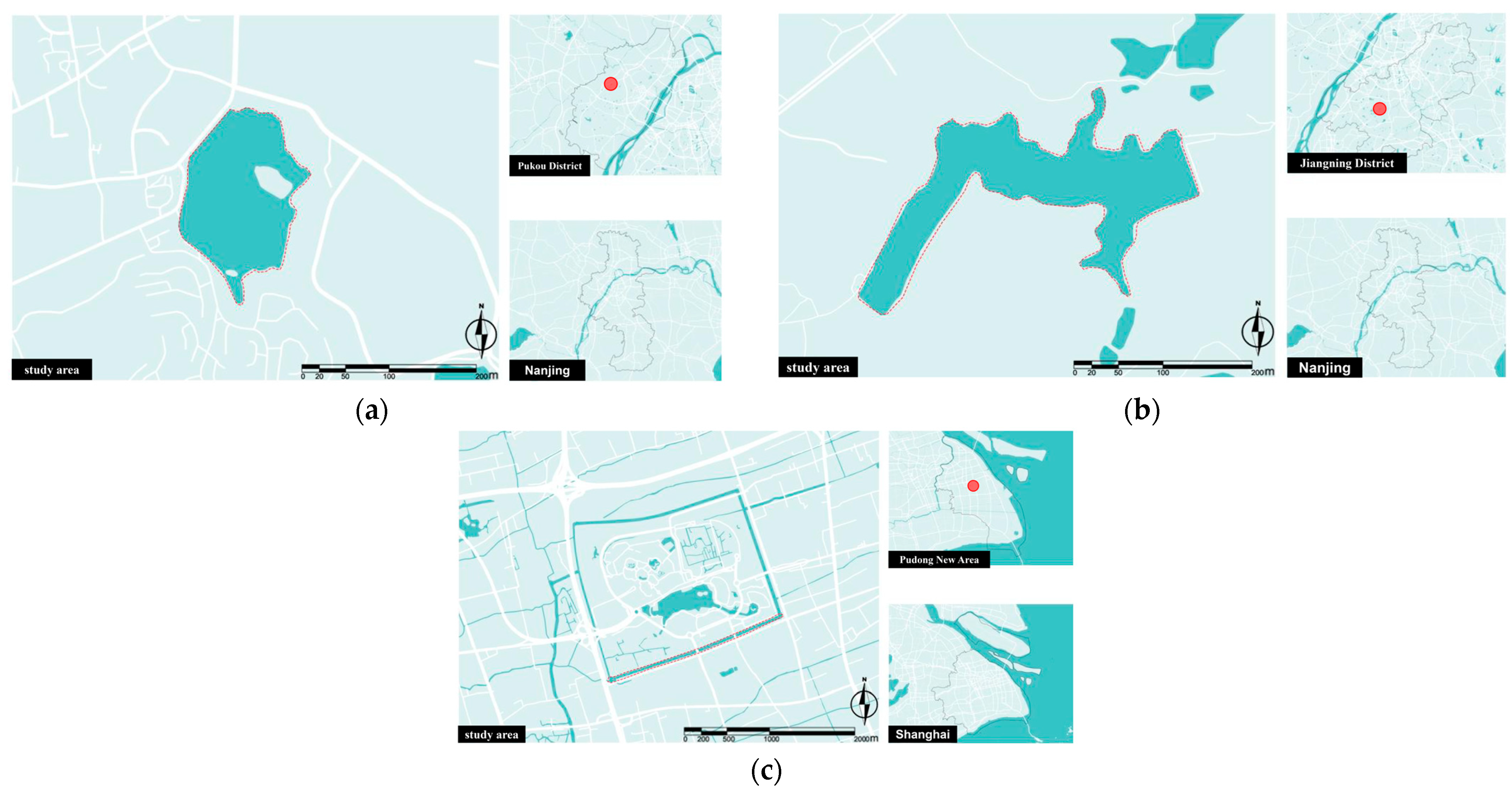
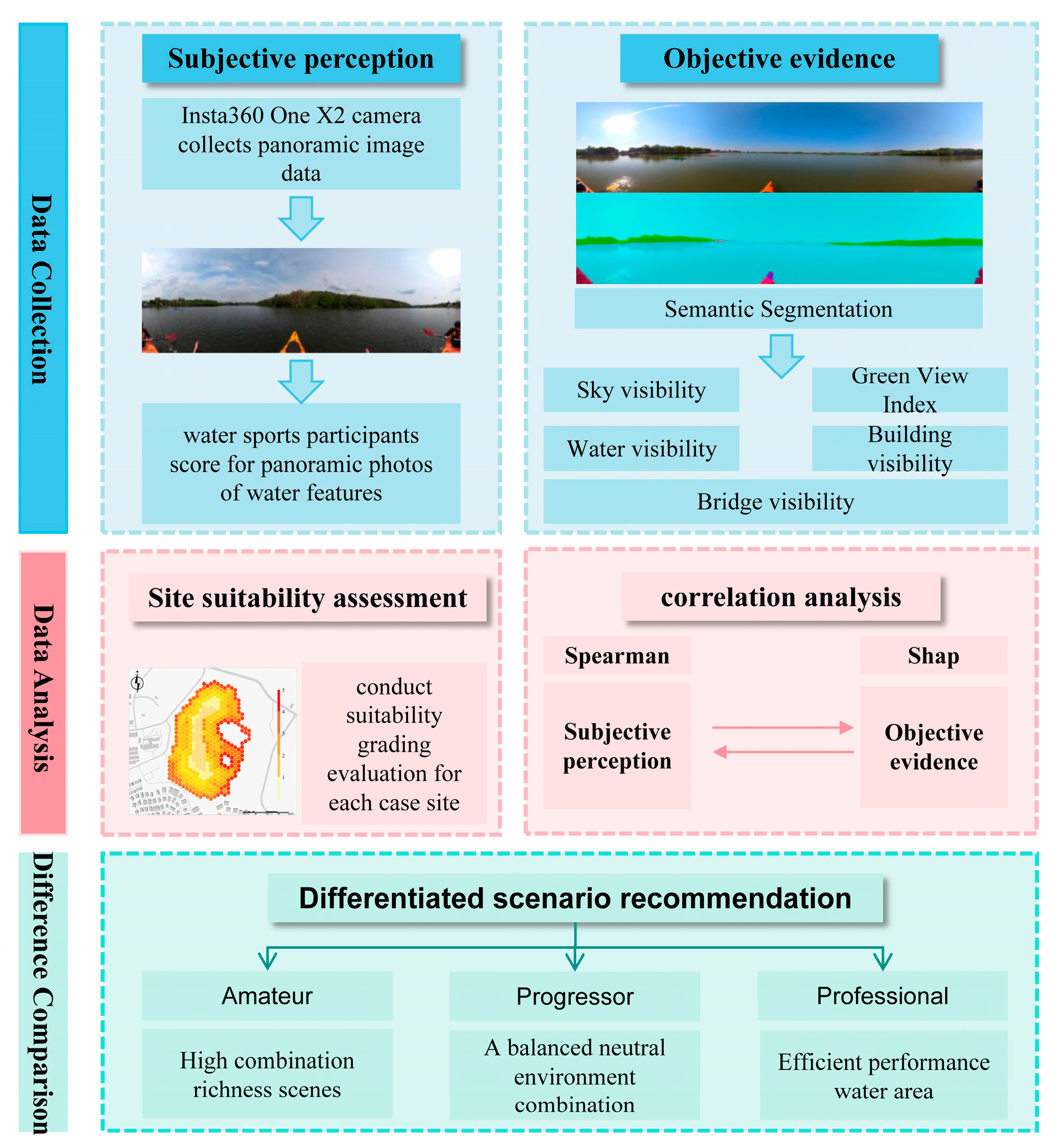



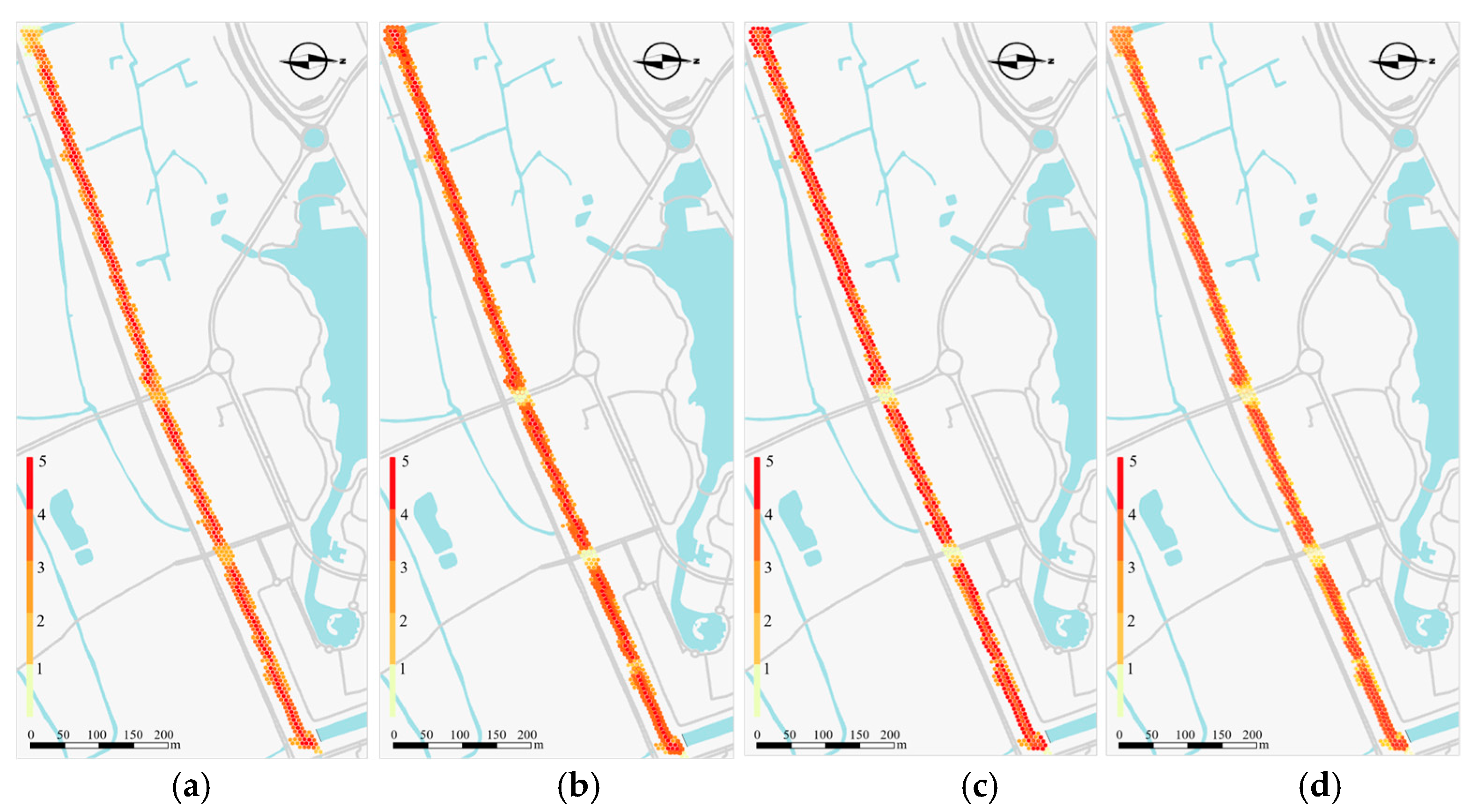
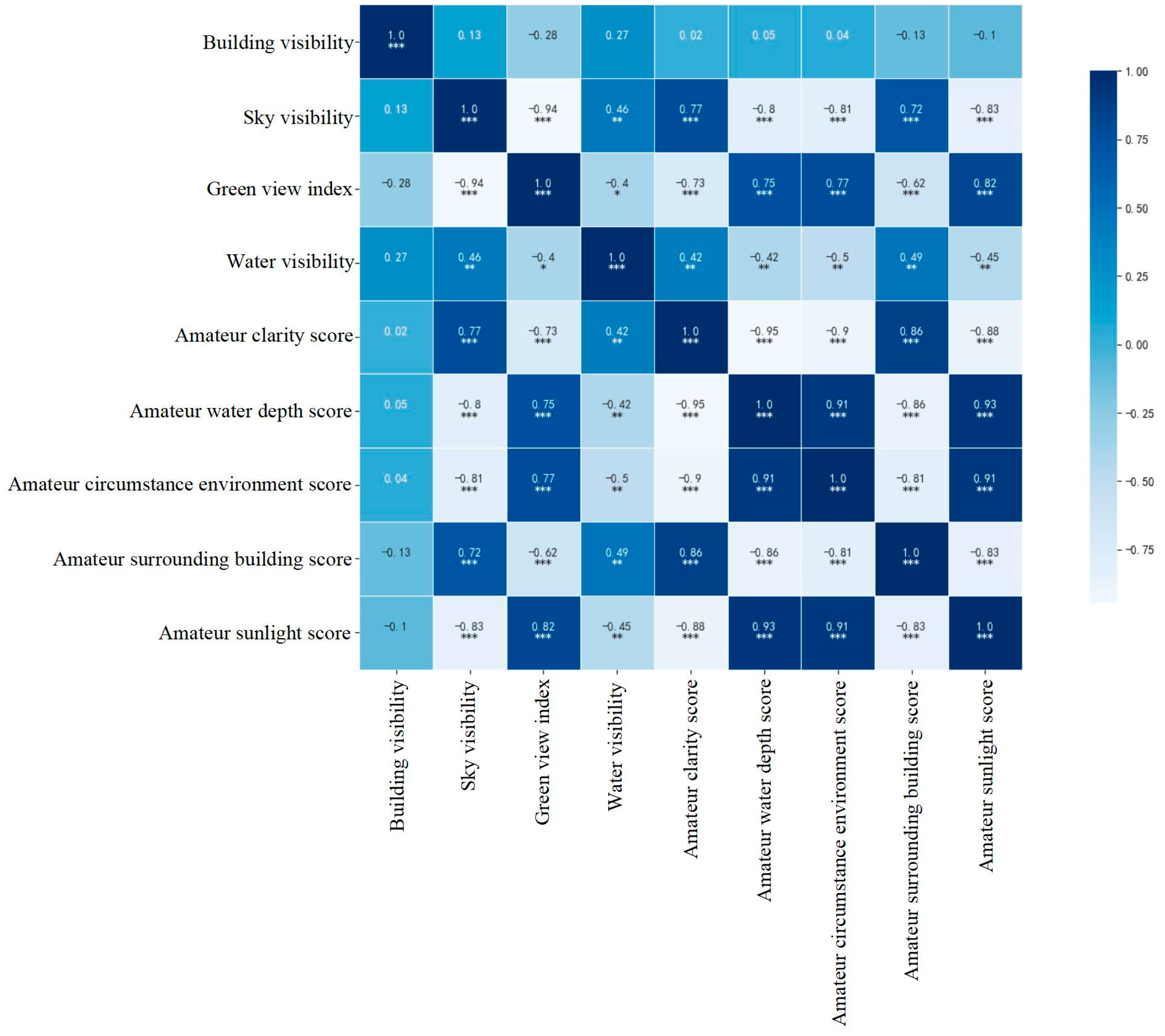


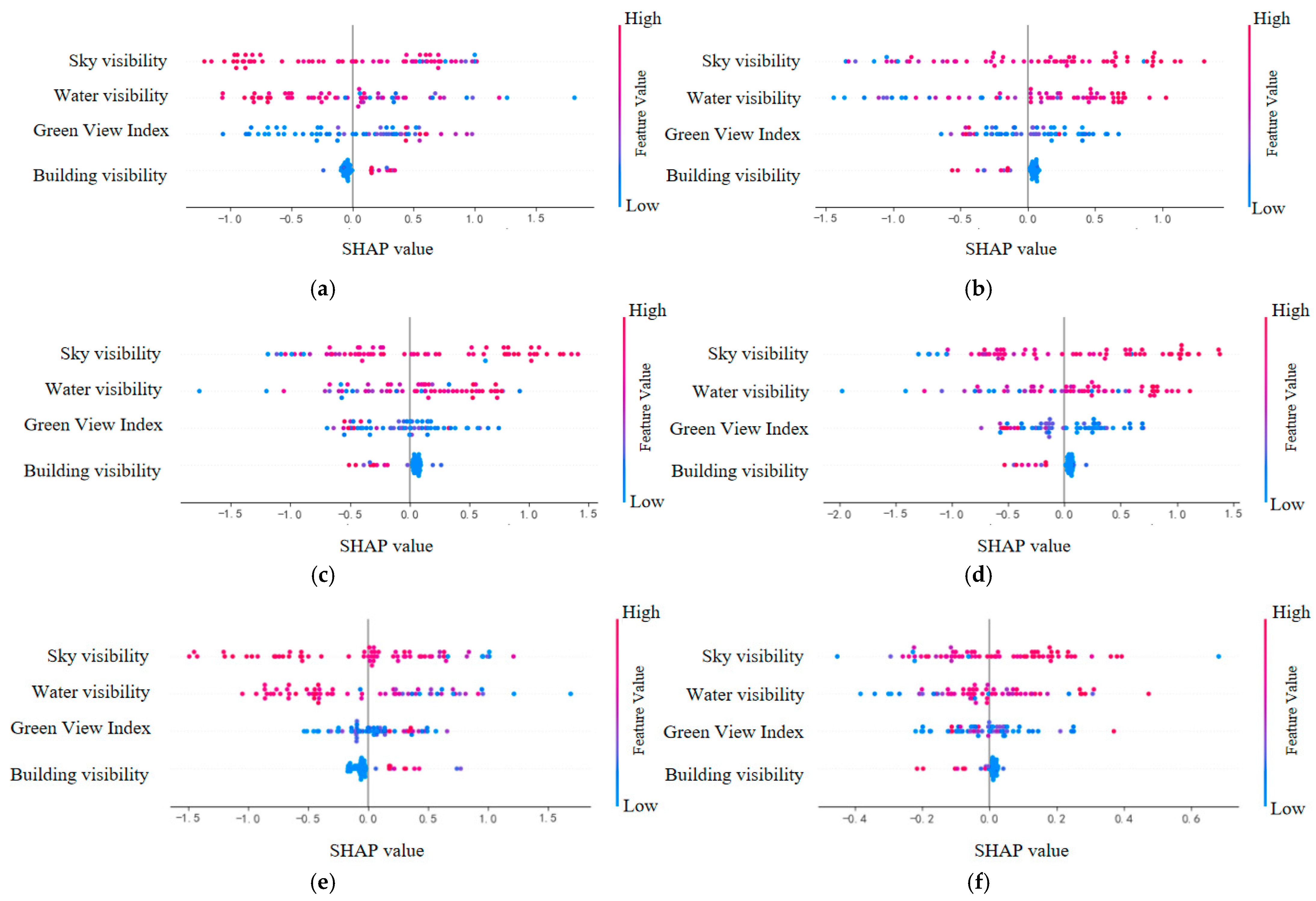
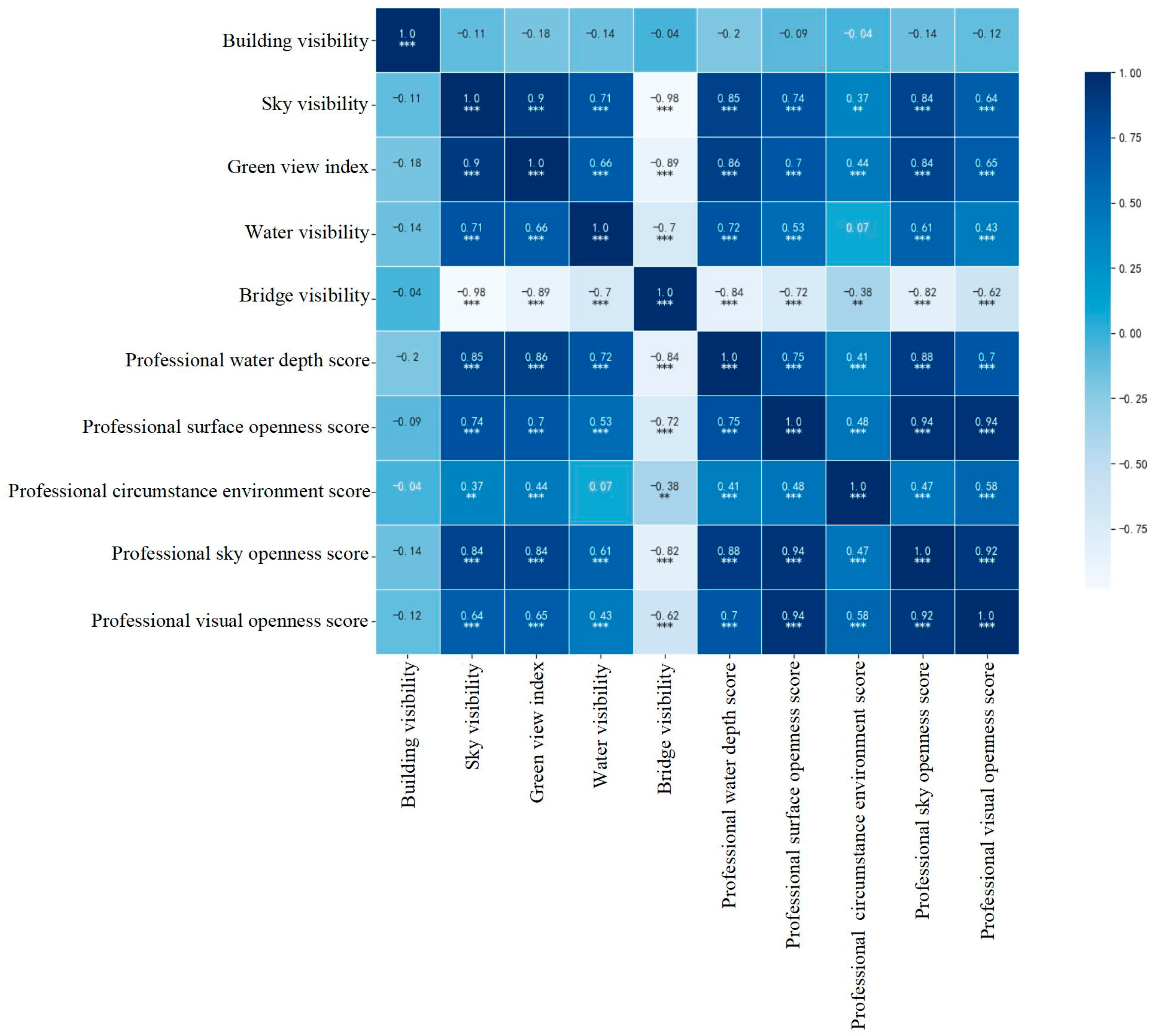
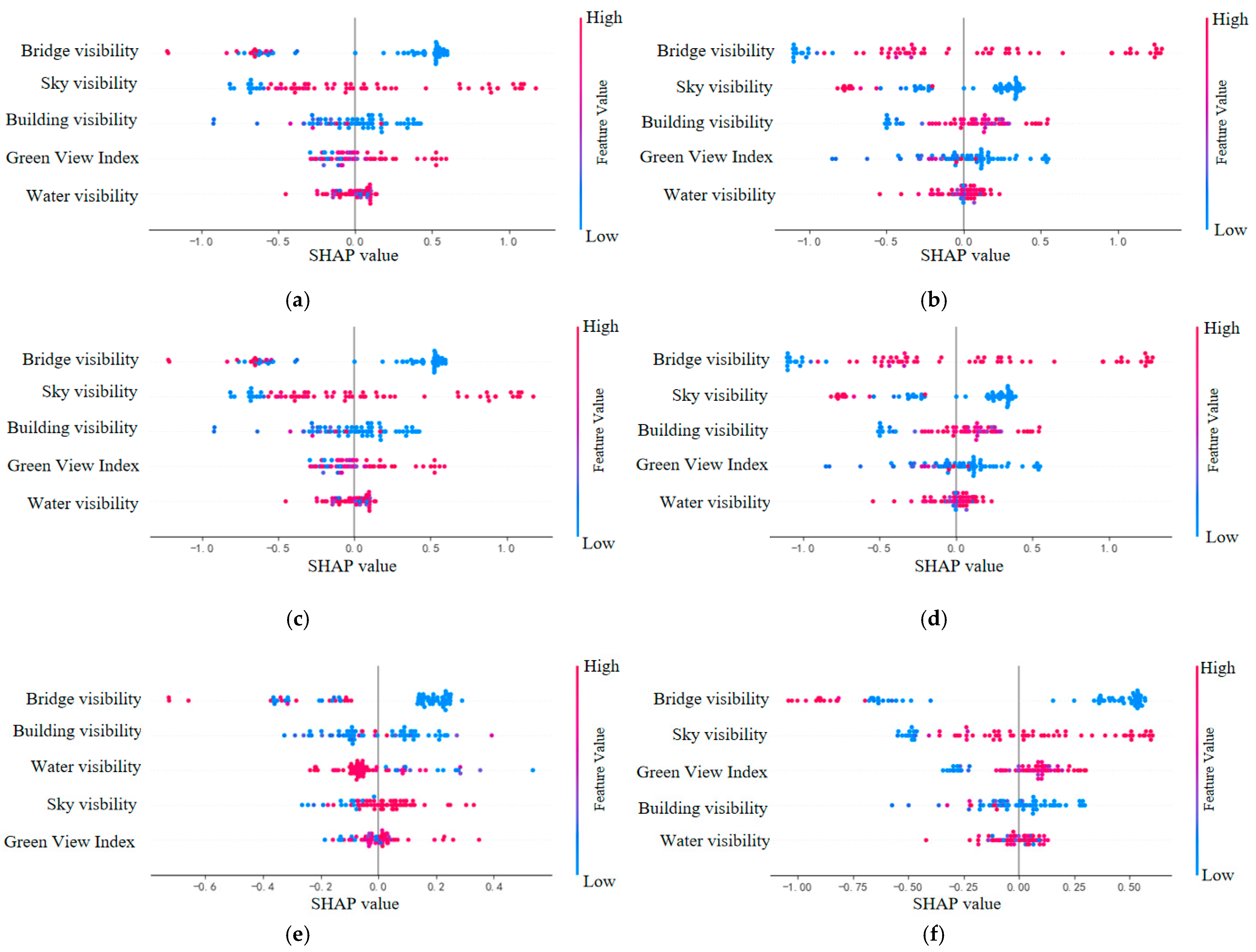
| Objective Evidence Indicators | 5 | 4 | 3 | 2 | 1 |
|---|---|---|---|---|---|
| Water depth | Very deep | Deep | Medium deep | Shallow | Very shallow |
| Clarity | Very clear | Clear | Medium clear | Slightly turbid | Turbid |
| Surface openness | Very spacious | Spacious | Medium spacious | Narrow | Very narrow |
| Sunlight | Very cool | Cool | Medium cool | Hot | Very hot |
| Greening richness | Excellent | Good | General | Poor | Very poor |
| Obstacles | No obstacle | Fewer obstacles | General obstacles | Multiple obstacles | Serious obstacles |
| Visual openness | Excellent | Good | Average | Poor | Extremely poor |
| Sky openness | Extremely open | Open | Generally open | Narrow | Extremely narrow |
| Circumstance environment | Excellent | Good | Ordinary | Poor | Harsh |
| Surrounding buildings | Extremely sparse | Sparse | Medium dense | Dense | Extremely dense |
| Objective Evidence | Subjective Perception Indicators for Amateurs | Subjective Perception Indicators for Progressors | Subjective Perception Indicators for Professionals | Ade20k |
|---|---|---|---|---|
| Water visibility | Water depth, clarity | Water depth | Water depth, surface openness | Water |
| Green view index | Circumstance environment | Greening richness | Circumstance environment | Grass, tree |
| Building visibility | Surrounding buildings | Obstacles | Building | |
| Sky visibility | Sunlight | Sunlight, sky openness | Sky openness | Sky |
| Bridge visibility | Visual openness | Bridge |
Disclaimer/Publisher’s Note: The statements, opinions and data contained in all publications are solely those of the individual author(s) and contributor(s) and not of MDPI and/or the editor(s). MDPI and/or the editor(s) disclaim responsibility for any injury to people or property resulting from any ideas, methods, instructions or products referred to in the content. |
© 2025 by the authors. Licensee MDPI, Basel, Switzerland. This article is an open access article distributed under the terms and conditions of the Creative Commons Attribution (CC BY) license (https://creativecommons.org/licenses/by/4.0/).
Share and Cite
Wang, N.; Zhang, C.; Dai, L.; Wei, W.; Pang, D. Management of Urban Water Landscape Facilitating Multi-Layer Water Sports: Subjective Perception and Objective Evidence. Water 2025, 17, 3292. https://doi.org/10.3390/w17223292
Wang N, Zhang C, Dai L, Wei W, Pang D. Management of Urban Water Landscape Facilitating Multi-Layer Water Sports: Subjective Perception and Objective Evidence. Water. 2025; 17(22):3292. https://doi.org/10.3390/w17223292
Chicago/Turabian StyleWang, Nan, Chengxi Zhang, Ling Dai, Weixuan Wei, and Degong Pang. 2025. "Management of Urban Water Landscape Facilitating Multi-Layer Water Sports: Subjective Perception and Objective Evidence" Water 17, no. 22: 3292. https://doi.org/10.3390/w17223292
APA StyleWang, N., Zhang, C., Dai, L., Wei, W., & Pang, D. (2025). Management of Urban Water Landscape Facilitating Multi-Layer Water Sports: Subjective Perception and Objective Evidence. Water, 17(22), 3292. https://doi.org/10.3390/w17223292






